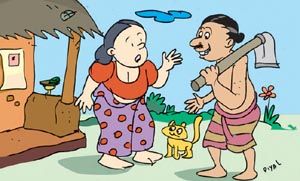|
Gaveshaka
looks at the rich legacy of folk tales We have a rich
legacy of stories, legends and myths. Story-telling thus forms an
integral part of our culture. Being a society with a Buddhist background,
it is natural that most stories are related to the life of the Buddha
and Buddha's former births as a Bodhisatva. The collection of 550
Jataka tales (Pansiya Panas Jataka Pota) relating to these former
births, provided enough material for the devotees to listen to.
While the book was available in most homes, it was on Poya day that
many listen to a Jataka story at the temple having observed 'ata
sil'. With only a handful in the village being educated, one elderly
male would be reading the Jataka Pota with others gathering round
him to sit and listen. These stories create a lot of piety and devotion
among the listeners who respond with regular chants of 'sadhu','sadhu'.
There were many popular Jataka stories and the grandmothers would
relate the easy to understand ones to the grand chidlren. Each story
invariably teaches a moral. Legends relate
stories of some historical value. The have come down the ages and
even if the whole story may not be entirely authentic, there would
be a link to a historical happening. Certain characters have been
transformed into legendary individuals. The memory of great kings
and national heroes last forever, through legendary tales. Folk tales
are simple stories woven round the village. The characters in our
folk tales are simple village people. They have a lot of humour
and are always meant as light entertainment. Very often the gamarala's
actions are foolish ones. Yet they are related with malice to none.
Most of the stories are connected with cultivation because ours
was, as it is now, an agricultural society. Take the story
of the 'gamarala' going to the heaven. It was the sight of huge
round marks indicating that someone had walked through his plot
of cultivated land ('hena') that started the ball rolling. He first
thought they were marks of a 'vangediya' - the mortar at home. He
wanted the damage done to his plot stopped. So having returned home,
he tied the mortar to a post so that it would not go on any more
rounds. But when he went in the evening, he saw that the mortar
had walked over the plants and eaten them. He appealed to the neighbours
to tie up their mortars, which they did. Yet the damage continued.
In anger he cut the mortar at home into pieces and burnt it. When the gamarala
decided to spend a night and catch the thief, he saw an unbelievable
sight. A white elephant came down from the sky, walked up and down,
ate some plants and destroyed many, and disappeared into the sky.
Having watched the whole scene, he got an idea. He wanted to go
and see the 'divya loke' by hanging on to the elephant's tail. No
sooner he related what he saw to the wife, the 'gamamahage', and
told his desire to go and see the heaven, she too wanted to go.
The 'henemama' - the family dhoby and the 'redinenda', the dhoby's
wife too would join. Having agreed, they went to the chena in the
evening and waited for the elephant to come. The animal came and
as planned, the 'gamarala' ran and hung on the tail. Others followed
with the wife holding on to the 'gamarala', the 'redinenda' to the
'gamamahage' and the 'henemama' hanging on to the wife. As the elephant
started going up, they were all excited and thrilled. They started
talking about the 'divya loke' and when the 'redinenda' in all her
innocence asked the 'gamarala' how big the 'kuruniya' used to measure
paddy in the heaven would be, he showed the size by stretching his
hands resulting in everyone crashing to the earth. The story is
narrated so beautifully that everyone listens eagerly and has a
hearty laugh at the end. While the 'gamarala' is a lovable character
in the village, he is famous for his follies, like the trip to the
'divya loke'. Apart from the tales connected with the 'gamarala's
family, there are ones which relate numerous incidents which happen
when he goes outside the village. He is always accompanied by his
servant, Duraya by name, who saves him from embarrassing situations.
Duraya is sharp and shrewd. He steps in at the right moment and
saves the day. The folk tales create a lot of amusement. They are pleasing to listen to. At the same time there is food for thought. "Don't be like the 'gamarala'. Think before you act" is the lesson taught by these simple tales. |
||||
Copyright © 2001 Wijeya Newspapers
Ltd. All rights reserved. |
 woven
round the 'gamarala' are so interesting that even if they are make-believe
tales, the listener gets carried away and more often than not is
convinced that they are true. They have come down through the generations
and can still be heard in village households.
woven
round the 'gamarala' are so interesting that even if they are make-believe
tales, the listener gets carried away and more often than not is
convinced that they are true. They have come down through the generations
and can still be heard in village households.